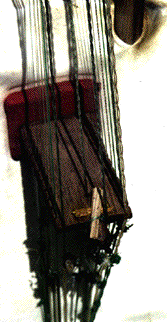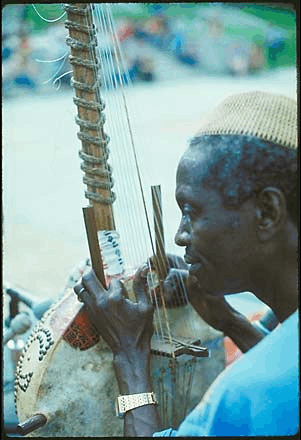 What is a Kora?
What is a Kora?

The Mandinka kora
is a unique instrument with a harp-like appearance and a notched bridge similar to that of a lute or guitar. It sounds somewhat like a harp, but its intricate playing style can be closer to flamenco guitar.The first known reference to the kora comes from Mungo Park in his 1799 book, Travels in Interior Districts of Africa. He describes it as "a large harp with 18 strings."
The kora's body is made from a calabash gourd cut in half and partially covered with cow skin. Traditionally, there are twenty-one playing strings plucked by the thumb and forefinger of each hand. The remaining fingers grip the two vertical hand posts. For strings, players use fishing line which provides a brillant tone and is easily obtained at the local market. Twenty-one anchor strings attach the playing strings to an iron ring bored through the base of the kora's hardwood neck. The player tunes the kora by moving the leather rings to achieve the appropriate tension on each string. Kora players use a variety of tunings.
The Gambia has more kora players than Mali, Guinea and Senegal. In these countries they sometimes use the French spelling cora.
Tuning The Kora
A traditional kora has 21 strings arranged in two parallel planes, with 11 strings for the left hand and 10 for the right. To play a scale you alternately pluck the left and right strings. The approach allows for the fast, scalewise runs characteristic of kora music. A great player like Alhaji Bai Konte incorporates rippling rhythms, elevating this technique to virtuoso levels. By moving the leather rings, up or down the kora's wooden neck, the player puts the instrument into one of four traditional tunings. Each tuning uses a heptatonic (7-note) scale, three of which approximate modes used in Western music--major, minor and lydian--and one that's reminiscent of the blues scale.
The music notation below shows where the strings are tuned in the key of
C. The number beside each note (pitch) places it within one of the kora's three octaves. The first two strings played by the thumbs on the left and right sides are tuned to the tonic (key's center). The actual pitch center for an individual kora depends on the musician's taste; typically the kora is tuned considerably higher, an A being pretty much the upper limit. Remember the higher you tune, the more likely your strings are going to break.
Kora bridge showing distribution of pitches

Here is another view of how the strings are arranged on the kora bridge.
Musicians in Gambia and in the Casamance--Senegal's region--have added extra bass strings. It is not uncommon to see a kora with as many as 23 strings there. In this close-up photo of the kora's bridge, note the two extra strings riding over the top of the bridge.

A rare picture of Alhaji Bai Konte performing at the 1973 Newport Jazz Festival (Central Park, New York City).
Here are two examples of what the kora sounds like as played by Alhaji Bai Konte
"Alla L'aa ke" [400K Mp3 ]
Traditional tuning pattern [300k Mp3 ] Typically played to check the kora's tuning at the start of a song.
These Sound Bytes are from the Bai Konte compact disk: "Kora Melodies from the Republic of the Gambia, West Africa
Sound Bytes courtesy & copyright © Rounder Records
Photograph of Bai Konte courtesy & copyright © Marc Pevar, all rights reserved.